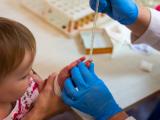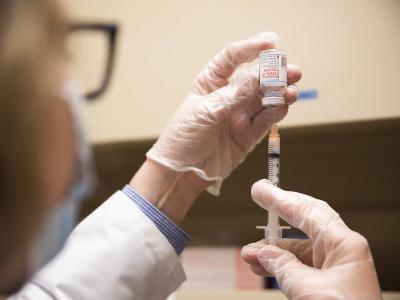Editor's Note: CIDRAP's Promising Practices: Pandemic Influenza Preparedness Tools (www.pandemicpractices.org) online database showcases peer-reviewed practices, including useful tools to help others with their planning. This article is one of a biweekly series exploring the development of these practices. We hope that describing the process and context of these practices enhances pandemic planning.
Jan 30, 2008 (CIDRAP News) – A statewide project in Kentucky engages communities to help vulnerable populations prepare for an emergency.
This grassroots group, called the Kentucky Outreach and Information Network (KOIN), was initiated by the Kentucky Cabinet for Health and Family Services. It brings together representatives from diverse community groups, faith-based organizations, health and social service agencies, and the media. Creating this network helps state health officials reach vulnerable populations with preparedness information; it also allows groups working with those populations to find and hone pertinent information.
Barbara Fox, KOIN coordinator and the information officer for Health and Family Services, said the network, which began in 2004, now has about 400 members serving "hard to reach" populations, including the deaf, blind, the elderly, the disabled, and those who speak limited or no English. (Kentucky is home to large Spanish- and Vietnamese-speaking populations.) KOIN planners also hope to reach out to homeless populations this year, Fox said.
An additional focus is on rural populations, as a substantial portion of Kentucky's 4.2 million residents live in rural areas. Knowing how to reach them when needed is essential, Fox said.
As the statewide KOIN project continues to grow, Fox said she hopes such networks also can be developed at the local health department level.
Workshops for educating, getting feedback
Fox holds annual workshops with KOIN members that have a twofold purpose: to raise awareness about disaster preparedness and to hear ideas on how best to reach different audiences. The network members are considered trusted local sources who can convey messages appropriately.
These sources include pastors and leaders of different faith groups, chaplains who visit local horse farms where there are many immigrant workers, and caseworkers from social service organizations that serve specific language or special needs groups. Other members, according to Fox, include ethnic media reporters, local radio hosts with programs that cater to particular populations, translators, healthcare workers, and others who provide direct services or have otherwise developed trusting relationships with the target populations.
"These are folks who really know their communities," Fox said. "It's kind of hard here at the state level to know what's going on." Ensuring crisis communication is particularly important for people who do not receive information through conventional channels.
A 2005 study in Kentucky on reaching vulnerable populations during emergencies found that during a crisis locally trusted sources gain more trust compared with outside sources (see link below). That finding underscores the importance of identifying and training such sources to dispatch information during a disaster.
The study also found that few of the vulnerable populations explored "felt adequately prepared for grave crisis, whether terrorism-related or the result of disease or natural disaster," according to the study's authors. KOIN provides an opportunity to improve that preparation.
Fox brings drafts of materials to workshops to solicit feedback from the network members and then incorporates changes, she said. "They point out a lot of things that we missed."
Network members are expected to share those materials with their constituencies, Fox said. She provides members with items such as community and media information guides, brochures, magnets, and coloring books.
"They adapt the information to meet the specific needs of their populations," Fox said.
Ever-evolving messages
Fox mainly communicates with contacts via a periodic newsletter, although in an emergency, e-mail and telephone calls will be used. She tries not to overwhelm members with too much information or responsibilities, she added.
"It's a volunteer network, so we can't demand things of these people," Fox said.
The network has already been tested on a few occasions. Recently, it was used to alert people about a Salmonella outbreak caused by peanut butter. It was also employed in bringing different people together for Kentucky's Pandemic Influenza Summit in 2006.
The KOIN project keeps exploring new ways to communicate emerging concerns such as pandemic influenza with special populations, Fox said. A new set of messages on preparedness is under development now.
"We're going to start testing the messages with seasonal flu," she said, adding that some of the approaches will be tested among different faith congregations, whose members have been useful in evaluating messages.
Language, other barriers
But challenges remain. For example, poor rural communities are of particular concern, Fox said, and communication in these areas may require unconventional methods. She said one of KOIN's member organizations, for instance, is able to reach people on horseback if needed. Health departments and individuals in these areas also have satellite phones in case standard systems break down.
In addition, communications to different audiences pose a number of challenges. For example, Fox said, "It's really hard to get materials into Braille."
Fox is also working on pictograms that teach people how to proceed through a flu clinic, which could be especially beneficial for populations with low literacy rates. "We're testing that out right now with our KOIN people, and they've been giving us a lot of pointers," she added.
In addition, the state's Vietnamese community would benefit greatly from having more materials translated. The 2000 census identified about 3,000 Vietnamese residents in Kentucky. Today that figure is closer to 7,000, said Thuy-Loan Nguyen, who works with the Louisville branch of Boat People SOS, a social services organization for Vietnamese immigrants.
Nguyen has been a KOIN member for 2 years. She said barriers such as poor English abilities, lack of transportation, and being poorly informed hinder preparedness in the Vietnamese community. "I don't think they are well-prepared," she said.
Boat People SOS has been sharing KOIN updates with eight local Vietnamese organizations, Nguyen said. More education and resources would be beneficial, a point she has raised at KOIN workshops. "We lack information in Vietnamese," Nguyen said. "We really need help."
One case study
Working with KOIN has helped the Christian Appalachian Project (CAP) plan disaster outreach and network with other organizations, according to Sherry Buresh, the organization's disaster relief program director. CAP offers more than 60 programs to different vulnerable populations, including the elderly, the disabled, and the poor in Kentucky, West Virginia, and Ohio.
CAP has plans to use a pool of staff and local volunteers to call, e-mail, or go door-to-door, especially in more remote areas, in an emergency. She noted that preparedness levels remain low among some residents, especially because rural and poor communities have other more pressing concerns.
"I feel real comfortable . . .that we would reach a large number of people," in an emergency, Buresh said. "[The KOIN project] is a very simple tool that could have a lot of impact."
See also:
2005 study: "Reaching vulnerable populations in widespread emergencies: lessons learned in Kentucky"
http://www.cidrap.umn.edu/sites/default/files/public/php/70/70_lessons_learned_0.pdf
















